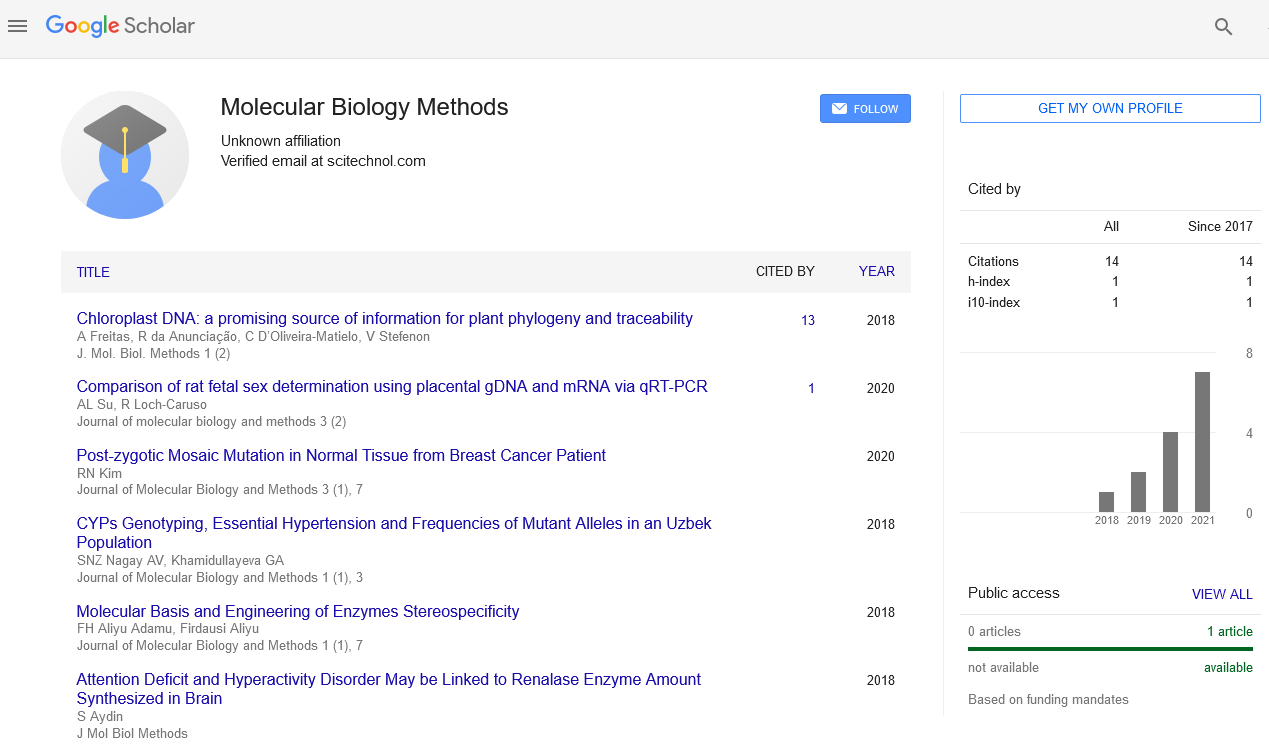Short Communication, J Mol Biol Methods Vol: 7 Issue: 2
Unveiling the Complexity of Molecular Biology: From Genes to Function
Pamuditha Smith*
1Department of Biology, Institute of Molecular Health Sciences, Zürich, Switzerland
*Corresponding Author: Pamuditha Smith,
Department of Biology, Institute of
Molecular Health Sciences, Zürich, Switzerland
E-mail: smithpamuditha@ethz.ch
Received date: 28 May, 2024, Manuscript No. JMBM-24-140282;
Editor assigned date: 31 May, 2024, PreQC No. JMBM-24-140282 (PQ);
Reviewed date: 14 June, 2024, QC No. JMBM-24-140282;
Revised date: 21 June, 2024, Manuscript No. JMBM-24-140282 (R);
Published date: 28 June, 2024, DOI: 10.4172/JMBM.1000166
Citation: Smith P (2024) Unveiling the Complexity of Molecular Biology: From Genes to Function. J Mol Biol Methods 7:2.
Description
Molecular biology, a cornerstone of modern biological sciences, delves deep into the intricate mechanisms that govern life at its most fundamental level. It explores the structure, function, and interactions of biomolecules within cells, providing profound insights into the mechanisms of inheritance, the basis of diseases, and the evolution of organisms. This note aims to elucidate the key concepts and advancements in molecular biology, highlighting its significance in unraveling the mysteries of life [1].
Replication of DNA is a fundamental process in molecular biology, ensuring faithful transmission of genetic information to subsequent generations of cells. During replication, the DNA unwinds and each strand serves as a template for the synthesis of a new complementary strand. This semi-conservative process is catalyzed by enzymes such as DNA polymerase, which ensures accuracy in the copying of genetic material [2-4].
Transcription is the process by which the genetic information encoded in DNA is transcribed into mRNA. This occurs in the nucleus of eukaryotic cells and involves RNA polymerase enzymes that catalyze the synthesis of mRNA from a DNA template. Posttranscriptional modifications, including capping, splicing, and polyadenylation, refine the mRNA molecule before it is transported to the cytoplasm for translation.
Translation is the process whereby mRNA is decoded by ribosomes to synthesize proteins. Transfer RNA (tRNA) molecules carry amino acids to the ribosome, where they are linked together in the order specified by the mRNA sequence. This sequence of amino acids folds into a specific three-dimensional structure, defining the function of the protein in cellular processes such as metabolism, signaling, and structural support [5-8].
Gene expression is tightly regulated to ensure that cells respond appropriately to internal and external stimuli. Regulatory mechanisms include transcription factors, which bind to specific DNA sequences to enhance or repress transcription, and epigenetic modifications, such as DNA methylation and histone acetylation, which modulate chromatin structure and accessibility of DNA to transcriptional machinery [9].
The principles of molecular biology have revolutionized biotechnology and medicine. Recombinant DNA technology enables the manipulation of DNA sequences to produce proteins of interest, such as insulin for diabetes treatment or vaccines against infectious diseases. Molecular diagnostics utilize techniques like Polymerase Chain Reaction (PCR) to detect genetic mutations or pathogens with high sensitivity and specificity, aiding in disease diagnosis and prognosis [10].
Genomics, the study of entire sets of genes and their interactions, has expanded our understanding of biological systems at a genomic scale. Advances in high-throughput sequencing technologies have enabled the sequencing of entire genomes, facilitating Genome-Wide Association Studies (GWAS) to identify genetic variants associated with diseases and traits. Comparative genomics elucidates evolutionary relationships between species, shedding light on the diversity and adaptation of life forms.
Systems biology integrates computational modeling and experimental data to understand the complex interactions within biological systems. By analyzing networks of genes, proteins, and metabolites, systems biology aims to uncover emergent properties and predict the behavior of biological systems under different conditions. Synthetic biology applies engineering principles to design and construct novel biological systems or redesign existing ones for practical applications, ranging from biofuel production to environmental remediation.
References
- Marusyk A, Polyak K (2010) Tumor heterogeneity: causes and consequences. Biochim Biophys Acta Rev Cancer 1805(1):105-17.
- Alizadeh AA, Aranda V, Bardelli A, Blanpain C, Bock C et al (2015) Toward understanding and exploiting tumor heterogeneity. Nat Med 21(8):846-53.
- Heppner GH, Miller BE (1983) Tumor heterogeneity: biological implications and therapeutic consequences. Cancer Metastasis Rev 2:5-23.
- Peter D, Ogawa S, Elhanani O, Keren L, Oliver TG (2021) Tumor heterogeneity. Cancer cell 39(8):1015-7.
- Shipitsin M, Campbell LL, Argani P, Weremowicz S, Bloushtain-Qimron N ET AL (2007) Molecular definition of breast tumor heterogeneity. Cancer cell 11(3):259-73.
- Davnall F, Yip CS, Ljungqvist G, Selmi M, Ng F et al (2012) Assessment of tumor heterogeneity: an emerging imaging tool for clinical practice?. Insights Imaging. 3:573-89.
- Stanta G, Bonin S (2018) Overview on clinical relevance of intra-tumor heterogeneity. Front Med 5:85.
- Hahn WC, Weinberg RA (2002) Rules for making human tumor cells. N Engl J Med 347(20):1593-603.
- Brooks SL (1993 ) Computed tomography. Dent Clin North Am. 37(4):575-90.
- Larkman DJ, Nunes RG (2007) Parallel magnetic resonance imaging. Phys Med Biol 52(7):R15.
 Spanish
Spanish  Chinese
Chinese  Russian
Russian  German
German  French
French  Japanese
Japanese  Portuguese
Portuguese  Hindi
Hindi 